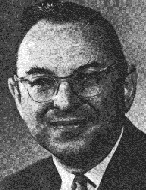Jerome Cornfield
Chair: 1958-1960

Jerome Cornfield had a relatively short tenure as fourth chair of the Department from 1958 to 1960. He then accepted a position at the National Heart Institute, where he spent most of his research career. Many of Professor Cornfield's numerous contributions to both biostatistics and public health grew out of his research on the health effects of smoking. He became interested in the use of case-control studies after reading seminal papers by Doll and Hill (1950) and Wynder and Graham (1950), which used this methodology in early discoveries of the association between smoking and lung cancer. Professor Cornfield then demonstrated that case-control studies can be used to estimate the risk of disease as a function of smoking status so long as the rate of disease in the population is known. He also showed that the odds ratio, an approximation to the relative risk for rare diseases, can be estimated either prospectively or retrospectively. These results form the basis for much of the modern era's epidemiologic research.
During the 1950s, Professor Cornfield became deeply involved in the debate over the relationship between smoking and lung cancer. Against strong opposition from R.A. Fisher and Joseph Berkson (a 1928 graduate of the Department), Professor Cornfield, along with Doll and Hill, argued that the association was causal. He and distinguished co-authors Haenszel, Lilienfeld, and Wynder (among others) prevailed with arguments put forth in their seminal 1959 paper in the Journal of the National Cancer Institute.
Professor Cornfield became an active proponent of the likelihood principle — that statistical evidence is summarized by the likelihood function — and of Bayesian inference. His important work on the foundations of biostatistical reasoning continues in the Department today.
